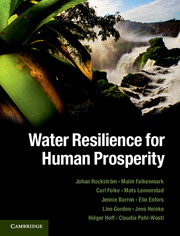Book contents
- Frontmatter
- Contents
- List of Contributors
- Preface
- Introduction to the book
- Acknowledgements
- Part I A new perspective
- Part II Living in a human-dominated world
- Part III Food production globally: in hotspot regions and in the landscape
- 5 Food production: a mega water challenge
- 6 Closing the yield gap in the savannah zone
- 7 Water resources and functions for agro-ecological systems at the landscape scale
- Part IV Governance and pathways
- Glossary
- Index
- References
7 - Water resources and functions for agro-ecological systems at the landscape scale
from Part III - Food production globally: in hotspot regions and in the landscape
Published online by Cambridge University Press: 05 August 2014
- Frontmatter
- Contents
- List of Contributors
- Preface
- Introduction to the book
- Acknowledgements
- Part I A new perspective
- Part II Living in a human-dominated world
- Part III Food production globally: in hotspot regions and in the landscape
- 5 Food production: a mega water challenge
- 6 Closing the yield gap in the savannah zone
- 7 Water resources and functions for agro-ecological systems at the landscape scale
- Part IV Governance and pathways
- Glossary
- Index
- References
Summary
This chapter analyses the implications of agricultural expansion on landscape multifunctionality in terms of water, and the related functions of agro-ecosystem services. Through manipulation of water stocks and flows, and landscape characteristics it is feasible to transform agricultural land from degraded to intermediate levels of multiple ecosystem services or beyond. The focus is on water balance alteration and within-stream and downstream effects for other users. The chapter highlights the landscape-scale resilience perspective, based on a set of landscape-scale indicators. It analyses three landscapes with rainfed cultivation, all in the tropical, semi-arid and sub-humid zone and under rapid transformation, and concludes that there is still potential to better utilise water functions and ecosystem services in most agricultural systems.
Social–hydrological–ecological systems at the landscape scale
Healthy water flows are key to sustaining the multiple ecosystem services that underpin the sustainability of social–ecological systems at the landscape scale (meso-scale, here defined as 1–10 000 km2 after e.g. Blöschl, 1996; Montanari and Uhlenbrook, 2004). Water shapes a range of provisioning, supporting, regulating and cultural ecosystem services, directly and indirectly through the presence or absence of water in time and space. This chapter discusses fundamental aspects of water and ecosystem services, and the management of these, with a particular emphasis on tropical, semi-arid and sub-humid zones experiencing rapid transformation and development for human benefit.
- Type
- Chapter
- Information
- Water Resilience for Human Prosperity , pp. 194 - 224Publisher: Cambridge University PressPrint publication year: 2014



